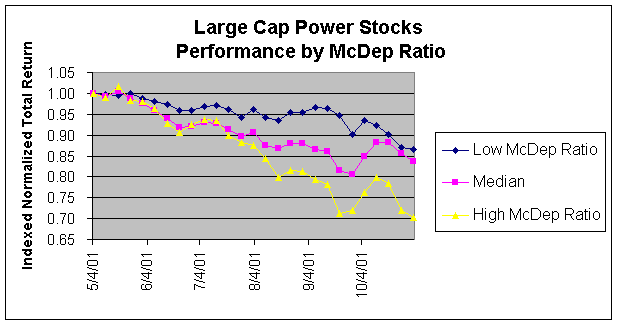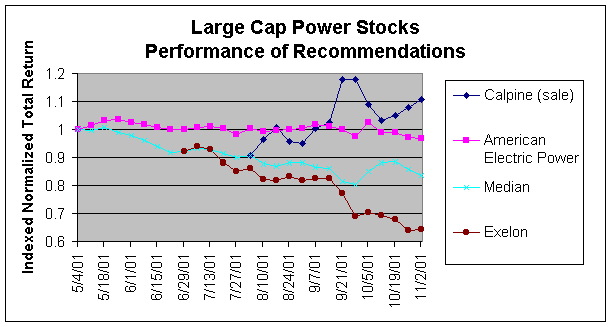November
5, 2001; McDep Analysis Helps Differentiate Power Stock Performance
A
half-year ago we added power stocks to broaden our oil and gas orientation to an
energy emphasis. Fortunately we can
take some encouragement from how the McDep Ratio has helped anticipate
performance of power stocks as it has helped us in oil and gas for a long time.
First,
the technique appears to be working. Low
McDep Ratio stocks outperformed the median and High McDep Ratio stocks.
Vice-versa, High McDep Ratio stocks underperformed the median and Low
McDep Ratio stocks (see Chart).
Second,
among specific recommendations, two positives offset one negative.
Our first recommendation, AEP, has outperformed by declining less in
price than the median power stock. Our
second recommendation, EXC, went the wrong way.
We recovered with our third power recommendation, the sale of CPN (see
Chart).
Here
are some definitions of our performance measurement. Total Return means appreciation plus dividends.
Normalized means adjusted for a normal debt ratio of 0.35.
That has the effect of understating return for high debt stocks and
overstating return for low debt stocks compared to the unadjusted results.
Without normalization, the buy of Exelon would not look as bad and the
sale of Calpine would look even more advantageous. Under indexing, the median starts at 1.0 when our coverage of
power companies started in May 2001. Recommendations
start at the index of the median at the time of recommendation.


Is
the measurement distorted by the collapse of Enron? We don't think so. High
(or Low) McDep Ratio stocks are the three highest (or lowest) of what is now a
group of 12 stocks. The
representative performance for the highest or lowest is the median of the three
stocks that may change in composition from week to week.
Most of the time the average would be about the same as the median.
Only in recent weeks when Enron's decline has accelerated would the
average of the three highest McDep Ratio stocks be much different (worse) than
the median. Because we did not use
the measure most influenced by Enron we think our performance measurement is
free of distortion by one stock.